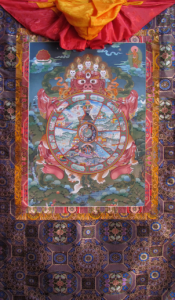What are thangka?
Thangka are traditional Tibetan Buddhist art. They are scroll-like paintings of Buddhas, deities, and mandalas mounted in brocade frames. For followers of Buddhism, these pieces would be placed in shrine-like areas, and used to help illustrate and deepen meditation practices, or Buddhist teachings.
The word thangka comes from the Tibetan thang yig, which mean “annal” or “written record.” The ending yig, which means, “letter” and carries the sense of “written,” is replaced by the ordinary substantive ending ka. Thus the word thangka has the sense of a record.
To learn more about the origin of this sacred art and its different schools, we recommend this excellent overview by Chogyam Trungpa Rinpoche.
 What is the traditional frame?
What is the traditional frame?
Thangka are meant to be portable; think of the Tibetan nomads and traveling Buddhist scholars, these frames allow the art to be easily moved to home shrines, or between monasteries.
The frames are representative of a window, looking into the Buddha’s world. They are made of brocade and silks. These frames have a silk overlay, which is meant to be closed to protect the thangka from everyday activities that may damage it.
How should I roll my thangka?
A thangka should always be rolled from the bottom to the top. When you roll it, be mindful not to grasp the canvas, but instead the brocade on the side. You should also be mindful to tie the hanging cords far to the side over the brocade, and not over the canvas itself. View a short video of proper hanging, framing, and rolling.
Traditionally, paints are naturally-sourced. Blue comes from lapis lazuli, red from cinnabar, and yellow from sulphur. Both mineral pigments and inks can be used for shading. The gold paint is actually mixed by the artist, using 24k gold and a natural animal skin-based glue. If you hold a thangka painted in the traditional fashion up to the light, you should see some reflections and shine from the ground minerals, almost quartz-like. Today, many thangka are painted with pre-fab paints, such as guache, or synthetic gold. Make sure to ask your artist, or the dealer what paints were used.
What are the different types of thangka?
Painted thangka are done in five styles:
1 – Full color
2- Red thangka
3- Black thangka
4- Silver thangka
5- Gold thangka
While all thangka can be painted in full color, there are limits on which Buddha’s can be painted in the other colorways. Green Tara, for example, should not be painted as a black thangka.
